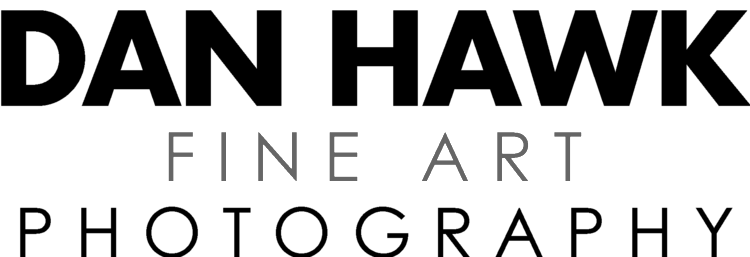Here is a preface to give perspective to this review. Please read the previous post which you could call a part 1 or a pre-review. It gives the reasons I decided to purchase a new camera. I’ll recap a little bit here as well, but there is quite a bit of detail that will give you an idea of the scope and intended audience for my review. The catalyst for my interest in photography is the iPhone 4 and 4S. Although they are great tools, they are somewhat limited. I decided I wanted to have a more specialized tool at my disposal to capture images that have felt out of my reach. I also know that one of the reasons I’m able to capture images consistently, is that I always have a good camera with me. For this reason, I really want a relatively small camera. There are certainly advantages to owning a bigger DSLR, but the size is (for me) an equal disadvantage.
So, on to the actual review.
The Sony Alpha NEX 5N

The Sony Alpha NEX 5N is a mirrorless camera with an interchangeable lens system and a larger sensor than you would typically find in a point and shoot camera. It is sort of a combination of the best features of larger “Profesional” DSLR cameras and convenient point and shoot cameras or cell phone cameras.
So, what are these best features? Well, lets review them. I’ll start with the smaller point and shoot camera.
- It is generally small and fits well into a pocket.
- Fairly easy to use, with knobs and menus that are intuitive.
- Inexpensive
The plusses of the larger DSLR are-
- Better low-light performance
- Manual control
- Far more detailed images
- Options- lots of them!
- Interchangeable lenses
- Broader focal choices ( In other words, tighter zoom, wider angle and everything in-between )
Here is how pulling these features together in one camera works:
Instead of a complex mirror system that is used to provided an optical viewfinder, the camera relies on the digital display that has become standard on most all digital cameras today. This allows for the body to be much smaller and lighter as the wieght of the mirrors and the moving parts are eliminated.
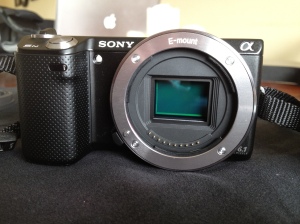
A sensor roughly the same size as those used in the larger more expensive cameras is used which give the ability to capture more data and create those sharp and detailed images that typically aren’t available on smaller cameras. Here is an illustration from Wikipedia showing the relative size of the sensors used on different cameras.

An interchangeable lens system is used giving you the ability to use different lenses for different situations. The lenses are smaller than you would find on a DSLR. Finally, a powerful, but intuitive menu system with all the manual controls you would expect and need for a “real camera” is used.
Contenders
This camera is part of a group or style known as “Mirrorless” because of the design mentioned above. There are a few other cameras that I considered which are similar to the 5N, but with minor differences. They all have bodies with roughly the same physical size, though the sensor and lens system varies a bit in size.
Olympus Pen E-PL3

The number one contender was the Olympus Pen E-PL3 which is a more traditionally styled camera that is part of the Micro Four Thirds format. This format uses a smaller sensor and because of this, a smaller lens system. Instead of trying to tell you why I think the Sony is a better camera, I’m going to link to a side-by-side review that I read thoroughly to make my decision. Long story made short, it seems to me like the Sony is a pretty clear cut winner in two ways.
* Because of the larger sensor, the Sony is more capable in low light situations and captures more raw data. * The menu system, which I did get to compare side-by-side is much more intutitive and better designed on the Sony.
Panasonic Lumix DMC-GX1

I looked at this camera as it is of a very similar size and spec as the Olympus and the Sony. I ultimately decided against it pretty early on as I didn’t care for the interface. It uses the same Micro Four Thirds Format Sensor size and lens system as the Olympus. It does have a higher density sensor (more megapixles) than the Olympus.
Because both of these cameras are part of the Micro Four Thirds system, there are more lenses available for them than for the Sony, but it wasn’t enough to tip the scales. I’ll go into more detail on lens availability later in the review.
So, how about image quality?
As someone without a lot of experience as a photographer, there are a handful of things I look for when judging image quality. Let me say right from the top that I’m not using technical terms, but instead am trying to think of, and share things in a more practical sense. This being said, I want real photos that I can use. For this reason I’m looking for:
- Sharp detail when zoomed in
- Accurate Color without having to do a ton of editing
- Good Contrast
- Rich Color

Perhaps the best way to share my thoughts is to tell you how I evaluated it and my reference points. My reference point is two-fold. My current go-to camera for the last 2 years has been the iPhone 4 and more recently the 4S. My other camera is a Canon SD900 which is a 10 Megapixel point and shoot with a zoom lens and a fairly large digital display. I’ve been happy with both of these, but the limitations are pretty straightforward. Both of these cameras have pretty small sensors and built-in small lenses.


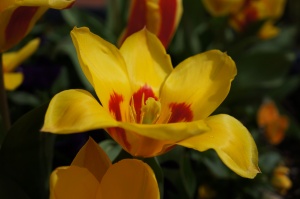

The images I’ve been capturing on this new camera are fantastic. They have so much detail that I can zoom in, crop and edit to my hearts content without worrying about resolution. I’ve also been surprised by how little editing is necessary. On the other cameras that I use, I’m used to adding additional contrast, saturation and prescence or brightness to match my perception of the scene. While I still do edit, it isn’t to make up for inaccurate color but more for effect and clarity.
Aperture
Another feature I’ve really enjoyed is the natural contrast between the in focus and out-of-focus areas in my photos. In photography, this blurring effect is called Bokeh, and is usually a mark of higher quality lenses. You just don’t get a lot of this with a point and shoot and it really doesn’t happen with the iPhone. In the side-by-side comparisons I’ve done with other cameras in this category, I found no match. A good portion of this quality comes from the quality of the lenses used and the size of the aperture.

Aperture is an important factor in the quality of the focus and the out-of-focus aspects in a photo. For those who are unfamiliar with photography terminology, the Aperture is the part of the lens that determines how much light is allowed in through the lens. It is like the iris in your eye and can function on its own in auto modes, or can be controlled by the photgrapher in Aperture priority or Fully manual mode.

So the aperture lets in more or less light, but how does it affect your photos? When you open up the Aperture, and more light is allowed to reach the sensor, the focusing plane is smaller, and anything that isn’t the same distance from the camera will be significantly out of focus. This is a great feature for portraits as it brings more emphasis to the subject.
If you tighten the aperture and let in more light, it creates a much broader focal plane and more of your photo will be in focus. This is more useful for landscape photos.

The aperture is indicated by the number after the focal length. As an example, the kit lens with my camera is the 18mm (focal length) 3.5–5.6 (aperture). Lenses with a smaller aperture are generally more expensive and are considered higher quality.
Lenses
Though there are a number of lenses available for the 5N, the kit that I purchased came with an 18–55mm Zoom lens with Aperature range of F3.5 to 5.6. This lens is a good all around lens for most folks because of its flexibiilty and range although it isn’t physically small as you can see in this picture.

That said, it isn’t huge either and is weighted well for the body.
One of the critiques of the Sony NEX cameras is that the lenses are a bit bulky because of the distance and space needed to accomadate the larger sensor. While other cameras can have a true “pancake” lens for easy portability, this camera is a little more limited.

The smallest lens in the system is the 16mm F2.8. This is a wide angle fixed lens with a wider aperture capability. This lens allows for bigger, more expansive landscape shots than are possible with the iPhone. I have a friend that bought another NEX system camera and this was the kit lens. I was able to borrow it for the last week. It is pretty nice, but I don’t know that I would choose it as a daily lens because of the extreme wide angle.

Experienced photographers will be interested in the selection of Fixed focal length , prime lenses available in the NEX system, and at this point, it is pretty limited. In addition, there have been rumors and even leaks directly from Sony in the form of a system roadmap indicating future lenses that will be available. If you are interested in knowing what is coming, a great resource is Sony Alpha Rumors. This is similar to other rumor sites, and there are updates every day.
In addition, there are quite a few different adaptors available on ebay and Amazon for using other lens systems on this body and I’ve actually ventured into this realm of things. I picked up an Olympus OM system fixed 50mm 1.8 lens and the adaptor. This is a really common kit lens included with the Olympus OM 35mm SLR Film cameras that were available in the later 70’s through 2002. Here is more history.

This lens is built like a tank, and takes fantastic photos. Because it isn’t part of the Sony system, it doesn’t “talk” to the camera and all functions are manual, but you have controls right on the lens for aperture and focus. When in manual focus mode on the Sony, there is a zoom function which allows you to look at a smaller cropped section of the photo while composing.


Because the Olympus lens has a larger aperture, the Bokeh effect is even more pronounced. I highly recommend these lenses. I’m already looking for another, probably a 35mm. After using this lens for the last week, I understand how lens collections get built.
Controls
The controls on the 5N are a combination of different types. While the lack of buttons and knobs are welcome from a aesthetic view, it also means you may have to dig fairly deep into menus for pretty common features. In fact, I’ll give you one recommendation right off the bat. Learn how to setup the user-programmable buttons. It is such an important step, that I’m going to give you some instructions on how to do it here.
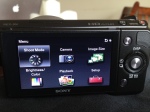
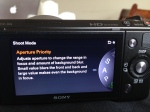
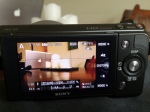

Touchscreen
The touchscreen on this camera is one of the most beautiful screens I’ve seen on a camera. It is an OLED type display and it is pretty impressive. It is the same screen Sony uses in the big brother to this model, the NEX 7. There is very little navigation that has to be done from the touchscreen and for the most part the touch controls are just a different way of doing what you can already do using the included buttons. There is one important difference though. When shooting, you can touch the subject you would like to be in focus. This will feel natural to folks used to using a smartphone with a touch screen, except for one thing. It is laggy. Touching the focus target, doesn’t result in an instant focus. Instead, the camera uses it as a suggestion and then proceeds to run through its normal focus process and eventually land somewhere in the vicinity of where you suggested.
Accessories
The kit for this camera comes with the Flash unit, a neck strap, a hood for the lens, the lenscap, and the battery. It doesn’t come with a body cap or a rear lens cap. The Flash fits into a receptacle on the top of the camera body directly above the lens mount. This same receptacle can also be used to plug in an optional digital view finder. This is a great accessory, but one I have not purchased.



Summary
I’m really happy with this camera. It fits my needs very well with enough room to tinker and yet enough automation to keep things running without too much maintenance. For someone with my background in photography, and my taste and standards, this camera strikes the perfect balance between portability and capability.

Perhaps one of the most telling things that I can say is that a friend with many years of professional photography and camera business experience considers this camera system and the images it creates as a viable alternative to his DSLR system. In fact many of the reviews are stating as much especially with the recent real-world availability of the big brother to my camera the NEX 7.

For some users, the lack of manual knobs will be unwelcome, but I think that the majority of people like me won’t mind. I do wish that there were a manual button for flash and for manual/auto focus, but other than that, I’m able to get to everything pretty well.
One thing that I wish wasn’t here and which is just a weird design decision is the placement of the Video record button. It’s right in a spot where I do push it fairly often accidentally and it literally just starts recording no-matter what you were doing previously. No software fix for something like that. I’ll just have to get used to it.

The NEX 5N is a very capable high resolution camera with the flexibility for you to try different lenses and to automate different parts of the process while you are experimenting with and learning about different variables in the photography process.
If, like me, you are finicky about user interface and usability, I can recommend this system wholeheartedly.
If I knew that a camera like this existed, I would’ve gotten serious about photography earlier.
- In full disclosure, Please note that the links to Amazon in the above review are affiliate links and I will receive a small amount of compensation if you purchase from here. As a side note, this is where and how I purchased my camera and a lot of other stuff. If you do too, thank you!
- I'm happy to answer any questions, just leave a note in the comments.
